#online python decision making
Explore tagged Tumblr posts
Text
Why Every Student Should Participate in a Hackathon
In today’s fast-paced digital world, the ability to solve problems creatively is just as important as technical skills. This is where a hackathon shines. Whether you're a developer, designer, or business-minded thinker, a hackathon gives you a unique platform to showcase your talent, build new skills, and contribute to innovative projects—often in just 48 hours.
If you're a student, participating in a hackathon might just be the smartest decision you can make for your personal and professional growth.
What is a Hackathon?
A hackathon is a collaborative event where teams work together intensively over a short period—usually one to three days—to build a project from scratch. While coding is a central part, modern hackathons welcome all kinds of talents: UI/UX designers, content creators, marketers, and product thinkers.
Hackathons often come with themes—like sustainability, mental health, AI, fintech, or social impact—which help guide participants to build projects around real-world challenges.
The Student Advantage: Why Join a Hackathon?
If you’re still in college or university, here are a few solid reasons to sign up for your first hackathon:
1. Learn by Doing
A hackathon is one of the best places to learn hands-on. You’ll get to apply classroom theories to real-world projects, often learning more in one weekend than in an entire semester. You’ll also pick up new tools, technologies, and frameworks on the go.
2. Build Your Resume and Portfolio
Participation in a hackathon instantly boosts your resume. Employers love to see initiative, teamwork, and problem-solving skills—all of which are demonstrated by joining a hackathon. If you create something impactful, it could even become a long-term project or startup idea.
3. Network with Industry Experts
Many hackathons feature mentors from top companies and industries. This is your chance to ask questions, get feedback, and even connect with potential recruiters. Some companies even hire interns or offer job interviews during or after the event.
4. Win Prizes and Scholarships
While not the main goal, many hackathons offer cash prizes, internships, tech gadgets, and free software licenses. Some also provide travel scholarships or job offers to outstanding teams.
5. Collaborate and Build Friendships
You’ll work closely with peers from different departments or even universities. Hackathons foster a spirit of teamwork and trust—and you may just walk away with lifelong friends or co-founders.
How to Prepare for Your First Hackathon
Pick your tools early: Whether it's Python, React, Figma, or Firebase, be comfortable with at least one or two tools.
Form a balanced team: Find people with different strengths—developers, designers, and storytellers.
Have a problem-first mindset: Instead of jumping into building, understand the user and the issue deeply.
Practice your pitch: Your idea might be amazing, but if you can’t explain it well in 2-3 minutes, judges may miss its value.
Stay open-minded: Hackathons are chaotic and dynamic. Be ready to learn, adapt, and pivot.
Choosing the Right Hackathon as a Student
There are thousands of hackathons held worldwide every year—on campuses, online, or hosted by organizations. Look for events that welcome beginners and provide mentorship. Sites like Devpost, MLH (Major League Hacking), HackerEarth, and local student communities are great places to start.
Also consider themed hackathons like:
Education hackathons for building student-focused tools
Green tech hackathons for solving climate problems
AI hackathons for machine learning enthusiasts
Conclusion
A hackathon is more than just an event—it’s an experience. It pushes your limits, grows your skills, and opens up new opportunities. As a student, you have nothing to lose and everything to gain. So step out of the classroom and into the hackathon arena. You might just discover your next passion, your dream job, or the idea that changes the world.
2 notes
·
View notes
Text
"Strange women lying in ponds, distributing swords, is no basis for a system of government!"

The other day, my favorite foreign policy wonk—Ian Bremmer (who strikes me as an extremely online dude)—published a very silly LinkedIn post in which someone used AI to recreate, with talking babies, the scene from Monty Python and the Holy Grail in which King Arthur meets two peasants or, ah, members of an "anarcho-syndicalist commune."
Because the writing is just beautiful, here's a transcript of the scene in question, presented more or less without commentary (it needs none; the progression from King Arthur *pretending to ride a horse* across a landscape to this bit of absurdly erudite political brilliance is sublime).
Apologies in advance for its length on the page/screen; come for King Arthur, stay for "autonomous collective" and the details of decision-making in the aforementioned anarcho-syndicalist commune:
King Arthur: Old woman! Man pulling cart: Man! King Arthur: Man, sorry. What knight lives in that castle over there? Man pulling cart: I'm 37. King Arthur: What? Man pulling cart: I'm 37, I'm not old. King Arthur: Well, I can't just call you man. Man pulling cart: Well, you could say "Dennis". King Arthur: I didn't know you were called Dennis! Dennis: Well, you didn't bother to find out, did you? King Arthur: I did say sorry about the old woman, but from you behind you looked... Dennis: What I object to is you automatically treating me like an inferior! King Arthur: Well, I am king. Dennis: Oh king, eh, very nice. And how'd you get that, eh? By exploiting the workers, by hanging on to an outdated imperialist dogma which perpetuates the economic and social differences in our society. If there's ever going to be any progress... Woman: Dennis! There's some lovely filth down here—oooh. How do you do? King Arthur: How do you do good lady, I am Arthur, king of the Britons. Whose castle is that? Woman: King of the who? King Arthur: The Britons. Woman: Who are the Britons? King Arthur: Well, we all are, we are all Britons, and I am your king. Woman: Didn't know we had a king, I thought we were an autonomous collective. Dennis: You're fooling yourself—we're living in a dictatorship, a self-perpetuating autocracy in which the working classes... Woman: Oh there go you, bringing class into it again! Dennis: Well that's what it's all about, if only people would... King Arthur: Please, please, good people, I am in haste. Who lives in that castle? Woman: No one lives there. King Arthur: Then who is your lord? Woman: We don't have a lord. King Arthur: What?! Dennis: I told you, we're an anarcho-syndicalist commune. We take it in turns to act as a sort of executive officer for the week... King Arthur: Yes. Dennis: ...but all the decisions of that officer have to be ratified at a special biweekly meeting... King Arthur: Yes I see. Dennis: ...by a simply majority, in the case of purely internal affairs... King Arthur: Be quiet! Dennis: ...but in a two-thirds majority in the case of... King Arthur: Be quiet! I order you to be quiet! Woman: Order, eh. Who does he think he is? King Arthur: I am your king! Woman: Well I didn't vote for you. King Arthur: You don't vote for kings! Woman: Well how'd you become king then? King Arthur: The lady of the lake—her arm clad in the purest shimmering samite—held aloft Excalibur from the bosom of the water, signifying by divine providence that I, Arthur, was to carry Excalibur. THAT is why I am your king! Dennis: Listen. Strange women lying in ponds, distributing swords, is no basis for a system of government. Supreme executive power derives from a mandate from the masses, not from some farcical aquatic ceremony. King Arthur: BE quiet! Dennis: But you can't expect to wield supreme executive power just cause some watery tart threw a sword at you! King Arthur: Shut UP! Dennis: If I went round, saying I was an emperor just because some moistened bink had lobbed a scimitar at me, they'd put me away! King Arthur: Shut up, will you shut up! Dennis: Ah, now we see the violence inherent in the system! King Arthur: Shut up! Dennis: Come and see the violence inherent in the system! Help, help, I'm being repressed! King Arthur: Bloody peasant! Dennis: Oh what a giveaway! Did you hear that, did you hear that, eh? That's what I'm on about!
...
Header image via Wikimedia Commons.
Gemini's definition of "anarcho-syndicalism" is as follows:
Anarcho-syndicalism is a form of anarchism that uses trade unions as the primary tool for social revolution and worker liberation. It combines anarchist principles with syndicalist strategies, aiming to abolish both capitalism and the state through worker-led direct action.
Here's another the-Pythons-really-could-write scene, the (in)famous Spanish Inquisition sketch:
youtube
4 notes
·
View notes
Text
Why Python Will Thrive: Future Trends and Applications
Python has already made a significant impact in the tech world, and its trajectory for the future is even more promising. From its simplicity and versatility to its widespread use in cutting-edge technologies, Python is expected to continue thriving in the coming years. Considering the kind support of Python Course in Chennai Whatever your level of experience or reason for switching from another programming language, learning Python gets much more fun.

Let's explore why Python will remain at the forefront of software development and what trends and applications will contribute to its ongoing dominance.
1. Artificial Intelligence and Machine Learning
Python is already the go-to language for AI and machine learning, and its role in these fields is set to expand further. With powerful libraries such as TensorFlow, PyTorch, and Scikit-learn, Python simplifies the development of machine learning models and artificial intelligence applications. As more industries integrate AI for automation, personalization, and predictive analytics, Python will remain a core language for developing intelligent systems.
2. Data Science and Big Data
Data science is one of the most significant areas where Python has excelled. Libraries like Pandas, NumPy, and Matplotlib make data manipulation and visualization simple and efficient. As companies and organizations continue to generate and analyze vast amounts of data, Python’s ability to process, clean, and visualize big data will only become more critical. Additionally, Python’s compatibility with big data platforms like Hadoop and Apache Spark ensures that it will remain a major player in data-driven decision-making.
3. Web Development
Python’s role in web development is growing thanks to frameworks like Django and Flask, which provide robust, scalable, and secure solutions for building web applications. With the increasing demand for interactive websites and APIs, Python is well-positioned to continue serving as a top language for backend development. Its integration with cloud computing platforms will also fuel its growth in building modern web applications that scale efficiently.
4. Automation and Scripting
Automation is another area where Python excels. Developers use Python to automate tasks ranging from system administration to testing and deployment. With the rise of DevOps practices and the growing demand for workflow automation, Python’s role in streamlining repetitive processes will continue to grow. Businesses across industries will rely on Python to boost productivity, reduce errors, and optimize performance. With the aid of Best Online Training & Placement Programs, which offer comprehensive training and job placement support to anyone looking to develop their talents, it’s easier to learn this tool and advance your career.

5. Cybersecurity and Ethical Hacking
With cyber threats becoming increasingly sophisticated, cybersecurity is a critical concern for businesses worldwide. Python is widely used for penetration testing, vulnerability scanning, and threat detection due to its simplicity and effectiveness. Libraries like Scapy and PyCrypto make Python an excellent choice for ethical hacking and security professionals. As the need for robust cybersecurity measures increases, Python’s role in safeguarding digital assets will continue to thrive.
6. Internet of Things (IoT)
Python’s compatibility with microcontrollers and embedded systems makes it a strong contender in the growing field of IoT. Frameworks like MicroPython and CircuitPython enable developers to build IoT applications efficiently, whether for home automation, smart cities, or industrial systems. As the number of connected devices continues to rise, Python will remain a dominant language for creating scalable and reliable IoT solutions.
7. Cloud Computing and Serverless Architectures
The rise of cloud computing and serverless architectures has created new opportunities for Python. Cloud platforms like AWS, Google Cloud, and Microsoft Azure all support Python, allowing developers to build scalable and cost-efficient applications. With its flexibility and integration capabilities, Python is perfectly suited for developing cloud-based applications, serverless functions, and microservices.
8. Gaming and Virtual Reality
Python has long been used in game development, with libraries such as Pygame offering simple tools to create 2D games. However, as gaming and virtual reality (VR) technologies evolve, Python’s role in developing immersive experiences will grow. The language’s ease of use and integration with game engines will make it a popular choice for building gaming platforms, VR applications, and simulations.
9. Expanding Job Market
As Python’s applications continue to grow, so does the demand for Python developers. From startups to tech giants like Google, Facebook, and Amazon, companies across industries are seeking professionals who are proficient in Python. The increasing adoption of Python in various fields, including data science, AI, cybersecurity, and cloud computing, ensures a thriving job market for Python developers in the future.
10. Constant Evolution and Community Support
Python’s open-source nature means that it’s constantly evolving with new libraries, frameworks, and features. Its vibrant community of developers contributes to its growth and ensures that Python stays relevant to emerging trends and technologies. Whether it’s a new tool for AI or a breakthrough in web development, Python’s community is always working to improve the language and make it more efficient for developers.
Conclusion
Python’s future is bright, with its presence continuing to grow in AI, data science, automation, web development, and beyond. As industries become increasingly data-driven, automated, and connected, Python’s simplicity, versatility, and strong community support make it an ideal choice for developers. Whether you are a beginner looking to start your coding journey or a seasoned professional exploring new career opportunities, learning Python offers long-term benefits in a rapidly evolving tech landscape.
#python course#python training#python#technology#tech#python programming#python online training#python online course#python online classes#python certification
2 notes
·
View notes
Text
Top 10 In- Demand Tech Jobs in 2025

Technology is growing faster than ever, and so is the need for skilled professionals in the field. From artificial intelligence to cloud computing, businesses are looking for experts who can keep up with the latest advancements. These tech jobs not only pay well but also offer great career growth and exciting challenges.
In this blog, we’ll look at the top 10 tech jobs that are in high demand today. Whether you’re starting your career or thinking of learning new skills, these jobs can help you plan a bright future in the tech world.
1. AI and Machine Learning Specialists
Artificial Intelligence (AI) and Machine Learning are changing the game by helping machines learn and improve on their own without needing step-by-step instructions. They’re being used in many areas, like chatbots, spotting fraud, and predicting trends.
Key Skills: Python, TensorFlow, PyTorch, data analysis, deep learning, and natural language processing (NLP).
Industries Hiring: Healthcare, finance, retail, and manufacturing.
Career Tip: Keep up with AI and machine learning by working on projects and getting an AI certification. Joining AI hackathons helps you learn and meet others in the field.
2. Data Scientists
Data scientists work with large sets of data to find patterns, trends, and useful insights that help businesses make smart decisions. They play a key role in everything from personalized marketing to predicting health outcomes.
Key Skills: Data visualization, statistical analysis, R, Python, SQL, and data mining.
Industries Hiring: E-commerce, telecommunications, and pharmaceuticals.
Career Tip: Work with real-world data and build a strong portfolio to showcase your skills. Earning certifications in data science tools can help you stand out.
3. Cloud Computing Engineers: These professionals create and manage cloud systems that allow businesses to store data and run apps without needing physical servers, making operations more efficient.
Key Skills: AWS, Azure, Google Cloud Platform (GCP), DevOps, and containerization (Docker, Kubernetes).
Industries Hiring: IT services, startups, and enterprises undergoing digital transformation.
Career Tip: Get certified in cloud platforms like AWS (e.g., AWS Certified Solutions Architect).
4. Cybersecurity Experts
Cybersecurity professionals protect companies from data breaches, malware, and other online threats. As remote work grows, keeping digital information safe is more crucial than ever.
Key Skills: Ethical hacking, penetration testing, risk management, and cybersecurity tools.
Industries Hiring: Banking, IT, and government agencies.
Career Tip: Stay updated on new cybersecurity threats and trends. Certifications like CEH (Certified Ethical Hacker) or CISSP (Certified Information Systems Security Professional) can help you advance in your career.
5. Full-Stack Developers
Full-stack developers are skilled programmers who can work on both the front-end (what users see) and the back-end (server and database) of web applications.
Key Skills: JavaScript, React, Node.js, HTML/CSS, and APIs.
Industries Hiring: Tech startups, e-commerce, and digital media.
Career Tip: Create a strong GitHub profile with projects that highlight your full-stack skills. Learn popular frameworks like React Native to expand into mobile app development.
6. DevOps Engineers
DevOps engineers help make software faster and more reliable by connecting development and operations teams. They streamline the process for quicker deployments.
Key Skills: CI/CD pipelines, automation tools, scripting, and system administration.
Industries Hiring: SaaS companies, cloud service providers, and enterprise IT.
Career Tip: Earn key tools like Jenkins, Ansible, and Kubernetes, and develop scripting skills in languages like Bash or Python. Earning a DevOps certification is a plus and can enhance your expertise in the field.
7. Blockchain Developers
They build secure, transparent, and unchangeable systems. Blockchain is not just for cryptocurrencies; it’s also used in tracking supply chains, managing healthcare records, and even in voting systems.
Key Skills: Solidity, Ethereum, smart contracts, cryptography, and DApp development.
Industries Hiring: Fintech, logistics, and healthcare.
Career Tip: Create and share your own blockchain projects to show your skills. Joining blockchain communities can help you learn more and connect with others in the field.
8. Robotics Engineers
Robotics engineers design, build, and program robots to do tasks faster or safer than humans. Their work is especially important in industries like manufacturing and healthcare.
Key Skills: Programming (C++, Python), robotics process automation (RPA), and mechanical engineering.
Industries Hiring: Automotive, healthcare, and logistics.
Career Tip: Stay updated on new trends like self-driving cars and AI in robotics.
9. Internet of Things (IoT) Specialists
IoT specialists work on systems that connect devices to the internet, allowing them to communicate and be controlled easily. This is crucial for creating smart cities, homes, and industries.
Key Skills: Embedded systems, wireless communication protocols, data analytics, and IoT platforms.
Industries Hiring: Consumer electronics, automotive, and smart city projects.
Career Tip: Create IoT prototypes and learn to use platforms like AWS IoT or Microsoft Azure IoT. Stay updated on 5G technology and edge computing trends.
10. Product Managers
Product managers oversee the development of products, from idea to launch, making sure they are both technically possible and meet market demands. They connect technical teams with business stakeholders.
Key Skills: Agile methodologies, market research, UX design, and project management.
Industries Hiring: Software development, e-commerce, and SaaS companies.
Career Tip: Work on improving your communication and leadership skills. Getting certifications like PMP (Project Management Professional) or CSPO (Certified Scrum Product Owner) can help you advance.
Importance of Upskilling in the Tech Industry
Stay Up-to-Date: Technology changes fast, and learning new skills helps you keep up with the latest trends and tools.
Grow in Your Career: By learning new skills, you open doors to better job opportunities and promotions.
Earn a Higher Salary: The more skills you have, the more valuable you are to employers, which can lead to higher-paying jobs.
Feel More Confident: Learning new things makes you feel more prepared and ready to take on tougher tasks.
Adapt to Changes: Technology keeps evolving, and upskilling helps you stay flexible and ready for any new changes in the industry.
Top Companies Hiring for These Roles
Global Tech Giants: Google, Microsoft, Amazon, and IBM.
Startups: Fintech, health tech, and AI-based startups are often at the forefront of innovation.
Consulting Firms: Companies like Accenture, Deloitte, and PwC increasingly seek tech talent.
In conclusion, the tech world is constantly changing, and staying updated is key to having a successful career. In 2025, jobs in fields like AI, cybersecurity, data science, and software development will be in high demand. By learning the right skills and keeping up with new trends, you can prepare yourself for these exciting roles. Whether you're just starting or looking to improve your skills, the tech industry offers many opportunities for growth and success.
#Top 10 Tech Jobs in 2025#In- Demand Tech Jobs#High paying Tech Jobs#artificial intelligence#datascience#cybersecurity
2 notes
·
View notes
Text
Machine Learning Training for Non-Tech Professionals: How to Get Started
For non-tech professionals, venturing into machine learning can seem intimidating. Yet, this field is becoming more accessible, presenting exciting opportunities for those ready to tackle new challenges. This guide will help you navigate the transition into machine learning roles, providing you with the essential knowledge and resources to start your journey with confidence. By following these steps, you'll be well on your way to harnessing the power of machine learning to enhance your career.
Understanding the Basics
Before you jump into the deep end, it's essential to grasp the fundamentals of machine learning. Start with understanding what machine learning is: it's a branch of artificial intelligence (AI) that involves training algorithms to learn from data and make predictions or decisions without being explicitly programmed. The core concepts include supervised learning, unsupervised learning, and reinforcement learning. Familiarizing yourself with these basics will provide a solid foundation for further exploration.
Identify Your Goals
Next, define why you want to learn machine learning. Are you looking to enhance your current role, switch careers, or start a new project? Knowing your goals will help you choose the right learning path. For instance, if you're in marketing, you might focus on predictive analytics. If you're in finance, you might be more interested in risk modeling.
Leverage Online Resources
There is a wealth of online resources designed to make machine learning accessible to non-tech professionals. Platforms like Coursera, edX, and Udacity offer introductory courses that cover the basics of machine learning without requiring a deep technical background. Look for courses that offer practical exercises and real-world applications, which can help bridge the gap between theory and practice.
Start with Data Analysis
One of the most crucial aspects of machine learning is data analysis. Learning how to handle and analyze data will make the transition smoother. Tools like Excel, Google Sheets, and basic statistical software are great starting points. Once you're comfortable with data handling, you can move on to more advanced tools like Python or R, which are commonly used in machine learning.
Choose the Right Training Program
For non-tech professionals, choosing a comprehensive and supportive training program is vital. Look for programs that offer structured learning paths, hands-on projects, and personalized support. Accelebrate is a renowned provider in this space, offering a wide range of courses designed to cater to different levels of expertise and industry needs. Their courses are known for their practical approach and expert instructors, making them an excellent choice for those new to the field.
Stay Updated and Keep Learning
Machine learning is a rapidly evolving field, and continuous learning is essential. Stay updated with the latest trends, tools, and technologies by following industry blogs, subscribing to relevant journals, and experimenting with new techniques and algorithms.
In Conclusion
Transitioning into a machine learning role as a non-tech professional is entirely achievable with the right approach and resources. To further accelerate your learning journey, consider enrolling in a course with Accelebrate. Their extensive range of machine learning courses is tailored to help professionals from all backgrounds gain the skills they need to succeed in the world of data and AI.
Embrace the challenge, and you'll find that the world of machine learning is not just for techies—it's for anyone willing to learn and innovate. Happy learning!
For more details, visit: https://www.accelebrate.com/machine-learning-training
2 notes
·
View notes
Text
snake update! (at last)
So! I joined my university’s reptile physiology research lab a few months ago (it’s been really cool and fun and fulfilling so far but that’s a separate post). And one day, my professor (/faculty advisor/interim dean/whatever the appropriate title is idk. everyone just calls her by her first name anyway) sends this message in the lab groupme:

[image id: a screenshot from June 8, 2023 at 1:40pm where the name and profile picture of the sender have been redacted for privacy and replaced with the word “Professor.” There is an image of a normal morph ball python in its enclosure, followed by a message that reads, “Baby ball python available. Free, comes with cage. This is a 20+ year commitment. Who wants it?” end id]
as far as I see it, the story is that a kid (~17yo) got the snake, but couldn’t keep it since his dad’s lease specified no pets 😔 so the family reached out to my advisor to try and rehome it.
now see, I love snakes, but I don’t know as much about ball pythons as I do about corn snakes (I was researching snake care and doing all the planning for Ophelia for *years* before I actually got her, which is what led me to being so passionate about herpetology in the first place), so I was hesitant to volunteer, especially on such short notice.
I didn’t want to make an impulsive decision and regret it later, so I messaged a whole bunch of people (including my girlfriend, my mom, my housemates, several online friends, and other people in the lab), but everyone I talked to about it encouraged me to get the snake, citing the fact that I already have experience with keeping snakes (I’ve had Ophelia since October) and that I actually had the capacity to take it in (other people wanted to, but couldn’t due to circumstance).
so I volunteered.

[image id: a screenshot from June 8, 2023 at 3:08pm where the name and profile picture of the sender have been redacted for privacy and replaced with the word “Me” with a message that reads “I’ll take him!” end id]
I had also volunteered to go to an outreach event with my advisor just a few days later, so we stopped by after the event to pick up the tank and I was able to bring her home! the tank fits perfectly on my desk right next to Ophelia.

[image id: two glass terrariums placed next to each other on a large desk. end id]
I had assumed it was a male since that’s how other people were referring to it, but based on the length of it’s tail I think it’s a female. I also tried the “popping” method and didn’t see any hemipenes, but I’m not too experienced with that so I could be wrong. All this to say, I originally named her Horatio, but the name didn’t really stick.
(for the record, I’m not against giving a female snake the name of a male character, gender is a social construct and the snake literally would not care, but she just didn’t seem like a Horatio. I did the same thing with Ophelia when I first got her.)
this is already a long post, so I’ll cut to the chase.
Behold, Gertrude!


[image id: two pictures of the same normal morph ball python from the image at the beginning of the post, this time being held by OP. In the first picture, the snake is resting, curled up in the palm of OP’s hand. In the second picture, the snake is in a more active position and is climbing around OP’s wrist and lower arm. end id]
#words words words#tl;dr i got a second snake it is a ball python and i named her gertrude#gertrude is the name of the queen from hamlet btw. though it could also count as a tma reference#i clearly have a theme going with my pet reptiles if you haven’t noticed#it started with a red eared slider (turtle) that I named hamlet#maybe someday I’ll get a snake and *actually* name it horatio but this was not that day#i hope my image descriptions are okay#i tried to make them relatively short but still appropriately informative#opheliaposting#<— technically#gertrudeposting#<— potential new tag? idk#ball python#herpetology#snakes
21 notes
·
View notes
Text
How Web Scraping TripAdvisor Reviews Data Boosts Your Business Growth
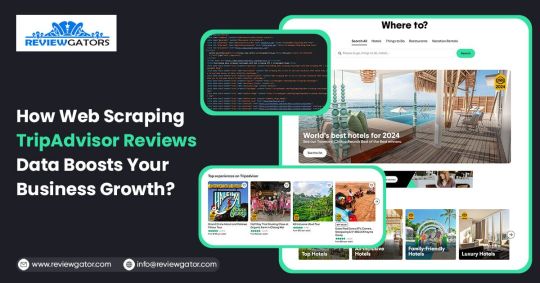
Are you one of the 94% of buyers who rely on online reviews to make the final decision? This means that most people today explore reviews before taking action, whether booking hotels, visiting a place, buying a book, or something else.
We understand the stress of booking the right place, especially when visiting somewhere new. Finding the balance between a perfect spot, services, and budget is challenging. Many of you consider TripAdvisor reviews a go-to solution for closely getting to know the place.
Here comes the accurate game-changing method—scrape TripAdvisor reviews data. But wait, is it legal and ethical? Yes, as long as you respect the website's terms of service, don't overload its servers, and use the data for personal or non-commercial purposes. What? How? Why?
Do not stress. We will help you understand why many hotel, restaurant, and attraction place owners invest in web scraping TripAdvisor reviews or other platform information. This powerful tool empowers you to understand your performance and competitors' strategies, enabling you to make informed business changes. What next?
Let's dive in and give you a complete tour of the process of web scraping TripAdvisor review data!
What Is Scraping TripAdvisor Reviews Data?
Extracting customer reviews and other relevant information from the TripAdvisor platform through different web scraping methods. This process works by accessing publicly available website data and storing it in a structured format to analyze or monitor.
Various methods and tools available in the market have unique features that allow you to extract TripAdvisor hotel review data hassle-free. Here are the different types of data you can scrape from a TripAdvisor review scraper:
Hotels
Ratings
Awards
Location
Pricing
Number of reviews
Review date
Reviewer's Name
Restaurants
Images
You may want other information per your business plan, which can be easily added to your requirements.
What Are The Ways To Scrape TripAdvisor Reviews Data?
TripAdvisor uses different web scraping methods to review data, depending on available resources and expertise. Let us look at them:
Scrape TripAdvisor Reviews Data Using Web Scraping API
An API helps to connect various programs to gather data without revealing the code used to execute the process. The scrape TripAdvisor Reviews is a standard JSON format that does not require technical knowledge, CAPTCHAs, or maintenance.
Now let us look at the complete process:
First, check if you need to install the software on your device or if it's browser-based and does not need anything. Then, download and install the desired software you will be using for restaurant, location, or hotel review scraping. The process is straightforward and user-friendly, ensuring your confidence in using these tools.
Now redirect to the web page you want to scrape data from and copy the URL to paste it into the program.
Make updates in the HTML output per your requirements and the information you want to scrape from TripAdvisor reviews.
Most tools start by extracting different HTML elements, especially the text. You can then select the categories that need to be extracted, such as Inner HTML, href attribute, class attribute, and more.
Export the data in SPSS, Graphpad, or XLSTAT format per your requirements for further analysis.
Scrape TripAdvisor Reviews Using Python
TripAdvisor review information is analyzed to understand the experience of hotels, locations, or restaurants. Now let us help you to scrape TripAdvisor reviews using Python:
Continue reading https://www.reviewgators.com/how-web-scraping-tripadvisor-reviews-data-boosts-your-business-growth.php
#review scraping#Scraping TripAdvisor Reviews#web scraping TripAdvisor reviews#TripAdvisor review scraper
2 notes
·
View notes
Text
Exploring Game-Changing Applications: Your Easy Steps to Learn Machine Learning:
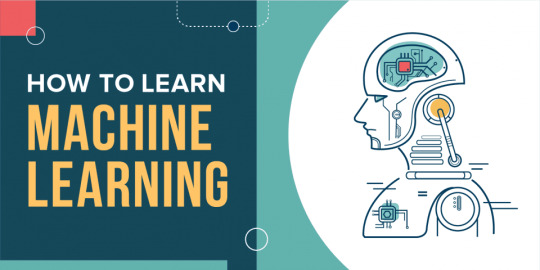
Machine learning technology has truly transformed multiple industries and continues to hold enormous potential for future development. If you're considering incorporating machine learning into your business or are simply eager to learn more about this transformative field, seeking advice from experts or enrolling in specialized courses is a wise step. For instance, the ACTE Institute offers comprehensive machine learning training programs that equip you with the knowledge and skills necessary for success in this rapidly evolving industry. Recognizing the potential of machine learning can unlock numerous avenues for data analysis, automation, and informed decision-making.
Now, let me share my successful journey in machine learning, which I believe can benefit everyone. These 10 steps have proven to be incredibly effective in helping me become a proficient machine learning practitioner:
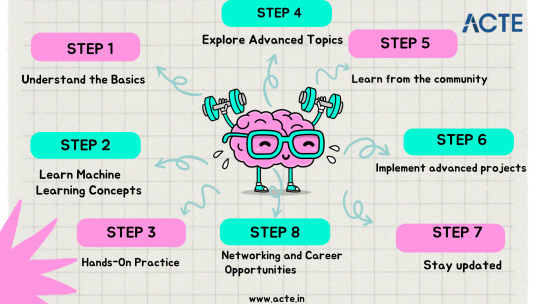
Step 1: Understand the Basics
Develop a strong grasp of fundamental mathematics, particularly linear algebra, calculus, and statistics.
Learn a programming language like Python, which is widely used in machine learning and provides a variety of useful libraries.
Step 2: Learn Machine Learning Concepts
Enroll in online courses from reputable platforms like Coursera, edX, and Udemy. Notably, the ACTE machine learning course is a stellar choice, offering comprehensive education, job placement, and certification.
Supplement your learning with authoritative books such as "Hands-On Machine Learning with Scikit-Learn, Keras, and TensorFlow" by Aurélien Géron and "Pattern Recognition and Machine Learning" by Christopher Bishop.
Step 3: Hands-On Practice:
Dive into real-world projects using both simple and complex datasets. Practical experience is invaluable for gaining proficiency.
Participate in machine learning competitions on platforms like Kaggle to challenge yourself and learn from peers.
Step 4: Explore Advanced Topics
Delve into deep learning, a critical subset of machine learning that focuses on neural networks. Online resources like the Deep Learning Specialisation on Coursera are incredibly informative.
For those intrigued by language-related applications, explore Natural Language Processing (NLP) using resources like the "Natural Language Processing with Python" book by Steven Bird and Ewan Klein.
Step 5: Learn from the Community
Engage with online communities such as Reddit's r/Machine Learning and Stack Overflow. Participate in discussions, seek answers to queries, and absorb insights from others' experiences.
Follow machine learning blogs and podcasts to stay updated on the latest advancements, case studies, and best practices.
Step 6: Implement Advanced Projects
Challenge yourself with intricate projects that stretch your skills. This might involve tasks like image recognition, building recommendation systems, or even crafting your own AI-powered application.
Step 7: Stay updated
Stay current by reading research papers from renowned conferences like NeurIPS, ICML, and CVPR to stay on top of cutting-edge techniques.
Consider advanced online courses that delve into specialized topics such as reinforcement learning and generative adversarial networks (GANs).
Step 8: Build a Portfolio
Showcase your completed projects on GitHub to demonstrate your expertise to potential employers or collaborators.
Step 9: Network and Explore Career Opportunities
Attend conferences, workshops, and meetups to network with industry professionals and stay connected with the latest trends.
Explore job opportunities in data science and machine learning, leveraging your portfolio and projects to stand out during interviews.
In essence, mastering machine learning involves a step-by-step process encompassing learning core concepts, engaging in hands-on practice, and actively participating in the vibrant machine learning community. Starting from foundational mathematics and programming, progressing through online courses and projects, and eventually venturing into advanced topics like deep learning, this journey equips you with essential skills. Embracing the machine learning community and building a robust portfolio opens doors to promising opportunities in this dynamic and impactful field.
9 notes
·
View notes
Text
Exploring the Python and Its Incredible Benefits:
Python, a versatile programming language known for its simplicity and adaptability, holds a prominent position in the technological landscape. Originating in the late 1980s, Python has garnered substantial attention due to its user-friendly syntax, making it an accessible choice for individuals at all levels of programming expertise. Notably, Python's design principles prioritize code clarity, empowering developers to articulate their ideas effectively and devise elegant solutions.
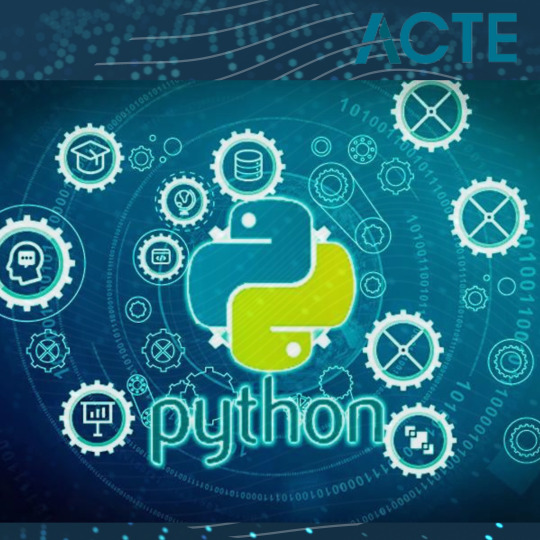
Python's applicability spans a multitude of domains, encompassing web development, data analysis, artificial intelligence, and scientific computing, among others. Its rich array of libraries and frameworks enhances efficiency in diverse tasks, including crafting dynamic websites, automating routine processes, processing and interpreting data, and constructing intricate applications.
The confluence of Python's flexibility and robust community support has driven its widespread adoption across varied industries. Whether one is a newcomer or an accomplished programmer, Python constitutes a potent toolset for software development and systematic problem-solving.
The ensuing enumeration underscores the merits of acquainting oneself with Python:
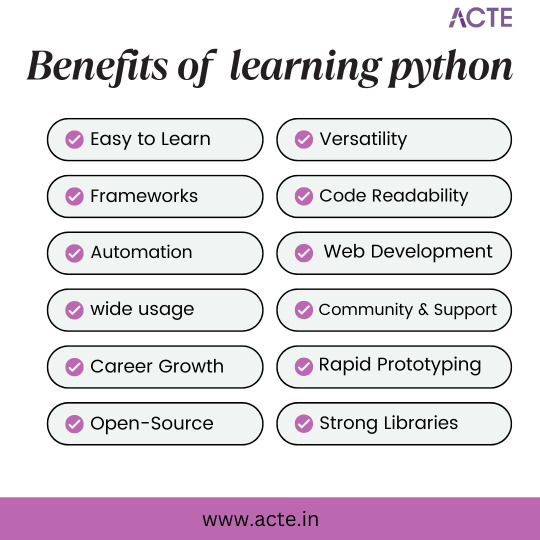
Accessible Learning: Python's straightforward syntax expedites the learning curve, enabling a focus on logical problem-solving rather than grappling with intricate language intricacies.
Versatility in Application: Python's versatility finds expression in applications spanning web development, data analysis, AI, and more, cultivating diverse avenues for career exploration.
Data Insight and Analysis: Python's specialized libraries, such as NumPy and Pandas, empower adept data analysis and visualization, enhancing data-driven decision-making.
AI and Machine Learning Proficiency: Python's repository of libraries, including Scikit-Learn, empowers the creation of sophisticated algorithms and AI models.
Web Development Prowess: Python's frameworks, notably Django, facilitate the swift development of dynamic, secure web applications, underscoring its relevance in modern web environments.
Efficient Prototyping: Python's agile development capabilities facilitate the rapid creation of prototypes and experimental models, fostering innovation.
Community Collaboration: The dynamic Python community serves as a wellspring of resources and support, nurturing an environment of continuous learning and problem resolution.
Varied Career Prospects: Proficiency in Python translates to an array of roles across diverse sectors, reflecting the expanding demand for skilled practitioners.
Cross-Disciplinary Impact: Python's adaptability transcends industries, permeating sectors such as finance, healthcare, e-commerce, and scientific research.
Open-Source Advantage: Python's open-source nature encourages collaboration, fostering ongoing refinement and communal contribution.
Robust Toolset: Python's toolkit simplifies complex tasks and accelerates development, enhancing productivity.
Code Elegance: Python's elegant syntax fosters code legibility, promoting teamwork and fostering shared comprehension.
Professional Advancement: Proficiency in Python translates into promising career advancement opportunities and the potential for competitive compensation.
Future-Proofed Skills: Python's enduring prevalence and versatile utility ensure that acquired skills remain pertinent within evolving technological landscapes.
In summation, Python's stature as a versatile, user-friendly programming language stands as a testament to its enduring relevance. Its impact is palpable across industries, driving innovation and technological progress.
If you want to learn more about Python, feel free to contact ACTE Institution because they offer certifications and job opportunities. Experienced teachers can help you learn better. You can find these services both online and offline. Take things step by step and consider enrolling in a course if you’re interested.
10 notes
·
View notes
Text
Exploring Career Options: Data Analytics vs. Digital Marketing
In the vast landscape of career choices, two fields have recently been in the spotlight: data analytics and digital marketing. Both offer promising avenues for growth and success, but they cater to different skill sets and interests. Whether you're inclined towards deciphering data or crafting compelling digital campaigns, understanding the intricacies of each field is essential for making an informed career decision.

In this blog post, we'll delve into the details of data analytics and digital marketing, highlighting their advantages, drawbacks, and potential career paths to help you navigate your professional journey effectively.
Data Analytics: Deciphering Insights From Data
Advantages of Data Analytics:
High Demand: Data analytics is witnessing a surge in demand as businesses increasingly rely on data-driven insights to drive their decisions. Professionals proficient in analyzing data are highly sought after across various industries.
Versatility: The skills acquired in data analytics are applicable across diverse sectors, including finance, healthcare, retail, and technology. This versatility opens doors to a wide range of career opportunities.
Lucrative Salaries: Skilled data analysts command competitive salaries due to their ability to extract valuable insights from complex datasets. The demand for their expertise translates into attractive compensation packages.
Drawbacks of Data Analytics:
Steep Learning Curve: Mastering data analytics requires proficiency in statistical techniques, programming languages like Python or R, and data visualization tools. The learning curve can be steep, especially for beginners.
Continuous Upskilling: The field of data analytics is constantly evolving, necessitating professionals to stay updated with the latest trends and technologies. Continuous upskilling is crucial to remain competitive.
Technical Complexity: Dealing with large datasets and complex algorithms can be challenging. Data analysts need to possess a high level of technical expertise and attention to detail to navigate through intricate data structures.
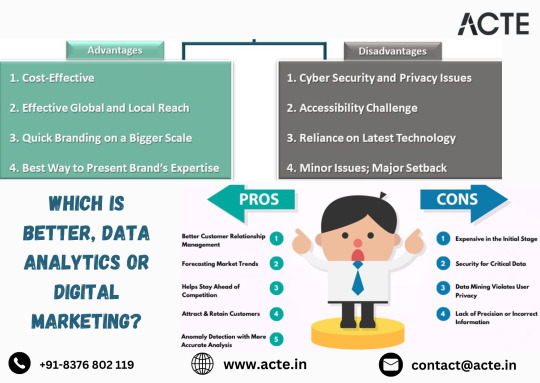
Digital Marketing: Crafting Compelling Campaigns in the Online Sphere
Advantages of Digital Marketing:
Creativity: Digital marketing offers ample opportunities for creative expression. From crafting engaging content to designing innovative campaigns, digital marketers have the freedom to unleash their creativity.
Immediate Impact: Digital marketing campaigns can yield quick results and reach a vast audience within a short span. The immediacy of impact makes it an appealing choice for those seeking tangible outcomes.
Diverse Career Paths: Digital marketing encompasses various roles, including social media management, content marketing, SEO, and email marketing. This diversity allows individuals to explore different career paths and areas of specialization.
Drawbacks of Digital Marketing:
Rapid Changes: The digital marketing landscape is constantly evolving, with new platforms, algorithms, and trends emerging regularly. Keeping up with these changes requires adaptability and continuous learning.
Metrics-Driven: Digital marketers need to analyze data and metrics to measure the effectiveness of their campaigns. While this provides valuable insights, it also requires a basic understanding of analytics tools and methodologies.
Competitive Field: With the accessibility of digital marketing tools and platforms, the field has become increasingly competitive. Professionals need to differentiate themselves through innovation and expertise to stand out.
Choosing the Right Path for You
Ultimately, the decision between data analytics and digital marketing depends on your individual strengths, interests, and career aspirations. If you have a penchant for numbers and enjoy uncovering insights from data, data analytics might be the ideal fit. Conversely, if you're passionate about storytelling, creative content creation, and engaging with audiences online, digital marketing could be your calling.
It's essential to consider your skills, interests, and long-term goals when making this decision. Whichever path you choose, both data analytics and digital marketing offer exciting opportunities for growth, learning, and career advancement. By understanding the intricacies of each field and aligning them with your aspirations, you can embark on a fulfilling professional journey tailored to your unique strengths and passions.
Conclusion
In conclusion, the choice between data analytics and digital marketing hinges on understanding your strengths, interests, and career goals. Both fields present distinct opportunities for growth and success, catering to different skill sets and preferences. Whether you're drawn to the analytical realm of data or the creative domain of digital promotion, there's no one-size-fits-all answer. Take the time to explore your options, evaluate your strengths, and chart a career path that aligns with your aspirations. With the right mindset and determination, you can carve out a rewarding career in either data analytics or digital marketing—or even both!
#tech#training#digital marketing#digital marketing company#digital marketing course#email marketing#online marketing#search engine optimization#seo#seo services
4 notes
·
View notes
Text
Foundations for Data Science Success: Essential Steps for Aspiring Professionals
Embarking on a journey into the world of data science is an exhilarating endeavor, promising the discovery of meaningful insights and contributions to cutting-edge advancements. However, achieving success in this dynamic field requires a robust skill set. In this article, we'll explore crucial prerequisites that will significantly enhance your prospects of securing a fulfilling position in data science.

Academic Background: Building a Solid Ground
A pivotal step in the pursuit of a data science career is cultivating the right educational foundation. Whether it's a degree in statistics, mathematics, computer science, or a specialized field like data science, acquiring foundational knowledge is crucial for comprehending the complexities of data analysis.
Programming Proficiency: Mastering the Language of Data
Proficiency in programming languages serves as a cornerstone for data science. Mastery of languages like Python and R is indispensable, given their widespread use in the field. Additionally, familiarity with essential libraries such as NumPy and pandas is vital for efficient data manipulation, a fundamental aspect of any data scientist's role.

Statistical Knowledge: Deciphering the Data Narrative
A profound grasp of statistical concepts lies at the core of data science. Understanding concepts like hypothesis testing, regression analysis, and probability theory equips data scientists with the tools needed to extract meaningful insights from intricate datasets.
Data Manipulation Skills: Crafting Clean and Usable Data
The ability to manipulate and clean data sets proficiently sets skilled data scientists apart. Learning techniques for handling missing values, addressing outliers, and utilizing tools like pandas for effective data formatting ensures that the data is in a usable state for in-depth analysis.
Data Visualization: Illuminating the Insights
Data visualization is the art of presenting complex findings in a clear and understandable manner. Familiarizing yourself with visualization tools such as Matplotlib, Seaborn, or ggplot2 enhances your capacity to communicate insights effectively, making data-driven decisions accessible to diverse audiences.
Communication Skills: Bridging the Technical Gap
Effective communication is a pivotal skill for any data scientist. The ability to convey complex findings to both technical and non-technical stakeholders is essential. Clear communication ensures that insights derived from data analysis are actionable and comprehensible across diverse teams.
Continuous Learning: Staying Ahead in a Dynamic Landscape
Data science is a swiftly evolving field with constant advancements in tools and techniques. Staying abreast of the latest trends through continuous learning is imperative. Engaging in online courses, webinars, and participating in the data science community are avenues for staying informed about industry developments.
Build a Robust Portfolio: Showcasing Your Expertise
A strong portfolio serves as your professional showcase. Showcasing real-world projects that highlight your problem-solving abilities and practical skills provides tangible evidence of your capabilities to potential employers.
In conclusion, by focusing on these essential prerequisites, you'll position yourself as a well-prepared candidate ready to navigate the intricate landscape of data science. While the journey may present challenges, a solid foundation and a commitment to continuous learning will enable you to confidently step into the dynamic and evolving world of data science, securing your first job with enthusiasm and expertise.
#data science course#datascience#technology#data science training#data science certification#tech#data analytics
2 notes
·
View notes
Text
Are There Chances of Chatgpt Replacing Programmers?

Artificial Intelligence (AI) is creating waves across various industries including the tech industry. The emergence of the various language models that include Chatgpt has left may wondering whether AI will be replacing the programmers. Chatgpt is a natural language chatbot that helps people write emails, college essays, song lyrics etc. Some of the earliest users of chatgpt have even used it to write the python code. The popularity of chatgpt has grown because of its practical applications. The question that however arises here is whether it will be able to replace the developers and the writers just as computers and robots have replaced cashiers and assembly line workers or perhaps the taxi drivers in the future. If you are interested in understanding how you can improve your work with chatgpt, you can pursue a good Search Engine Marketing Course In Gurugram.
Reasons for The Growing Popularity of Chatgpt
Chatgpt has been able to impress several people as it is able to simulate human conversations and also sounds quite knowledgeable. Chatgpt has been developed by OpenAI which is the creator of the most popular text to image AI engine called Dall- E. Chatgpt uses algorithms that helps in analysing and humans fine tune the system’s training to respond to the questions of the user with full sentences that sound similar to that of human beings.
Statistics Related to Chatgpt
A recent paper that was published by OpenAI revealed that as many as 80% of the US workforce have a minimum of 10% of their tasks affected by Chatgpt and other language models. Another research revealed that as many as 20% of the workers will find that 50% of their tasks will get affected by AI. If you want to become a web designer, you can get in touch with the best Search engine marketing institute in Gurgaon. Here you will get to learn about the use of chatgpt in the best way so that you are able to stay ahead in the competition.
The programmers can be relieved for now as it is not among the hundred professions that are going to be impacted by Chatgpt. Some of the professions that will be impacted include:
Why Will It Not Affect The Programmers?
Though Chatgpt is able to generate code and is also able to write programs, however, the process lacks proper understanding, problem solving ability and creativity that human beings have. It operates based on the patterns of the data that he was trained on. Like human programmers, it is not able to understand the code that it writes. It is also not able to understand the requirements of the projects and is not able to make It can’t understand project requirements, make architectural decisions to solve the human problems in a creative manner.
It is true that AI is able to automate repetitive tasks but programming is not just about writing codes. It is much more than that. Programming requires high level decision, personal interaction and strategic planning that AI is not able to do as these are elements that cannot be automated.
Software development is a creative field that requires users' understanding, based on feedback and sometimes abandoning the initial plans and starting all over again. All of these fall outside the realm of the AI capabilities. Pursuing a good online SEM course in Gurgaon will certainly benefit you.
Flaws of Chatgpt
1. Chatgpt has some flaws and limitations and that is why it cannot be a perfect content writing tool. It is also not a very reliable tool for creating codes as it is based on data and not on human intelligence. The sentences might sound coherent but they are not critically informed responses.
2. It is true that in the website of Chatgpt, you will find out ways that will help you debug code using this tool. But the responses are generated from prior code and it is incapable of replicating human based QA. This means that the code that it will generate will have bugs and errors. OpenAI have themselves accepted the fact that the tool at times writes plausible sounding but nonsensical and incorrect answers. So it is important for you to not use it directly in the production of any program.
3. The lack of reliability is creating a lot of problems for the developer community. In a question and answer website called Stack Overflow, where the coders used chatgpt to write and troubleshoot codes have banned its use. The reason for this is that there is such a huge volume of response generated by Chatgpt that it could not keep up with the quality which is done by humans. The average rate of getting correct answers in chatgpt is quite less. So, chatgpt is harmful for the site and for those people who are looking for correct answers from that site.
4. It is important to understand here that Chatgpt, like the other machine learning tools, is trained on data that suits its outcome. It is therefore unable to understand the human context of computing to do the programming properly. It is essential for the software engineers to understand the purpose of the software that they are developing and also the purpose of the people using it. It is not possible to create good software just by cobbling programs together.
Conclusion
So the simple answer to the question as to whether chatgpt will be able to replace the programmers is “No”. Chatgpt and the other AI tools can certainly automate the tasks, however they cannot replace human creativity, understanding and the problem solving capabilities. As of now we should consider AI as an augmenting force. It is a tool that helps programmers and software developers to be much more effective in their respective roles. Though chatgpt does have some flaws, if you want to learn to use it in the most effective way, you can get in touch with the Best SEM Training Institute in Gurgaon.
#digitaldrive360#seo#digital marketing training institute in gurgaon#sem course in gurgaon#digital marketing#online sem course in gurgaon#best sem training institute#digital marketing courses in gurgaon#digital marketing training in gurgaon#sem#digital marketing training institute#digital marketing institute#Digital Marketing Courses#Digital Marketing Course#Digital Marketing Course Gurgaon#Digital Marketing Course in Gurgaon#digital marketing institute Gurgaon#Digital Marketing Institute in Gurgaon#Online Digital Marketing Course gurgaon#Digital Marketing Courses Gurgaon#Online digital marketing course in gurgaon#best digital marketing institute in gurgaon#SEO Training Course Gurgaon#SEO Training in Gurgaon#SEO Training Course in Gurgaon#Search engine optimizaton institute in Gurgaon#SEO institute in Gurgaon#Best SEO Training in Gurgaon#SEO Course in Gurgaon#SEO Training Classes in Gurgaon
3 notes
·
View notes
Text
Unraveling Selenium's Testing Odyssey: Pros and Cons Unveiled
In the ever-evolving realm of software testing, Selenium stands as a stalwart, renowned for its versatility and capabilities. As testing teams explore this dynamic tool, it's essential to navigate through its strengths and challenges. This exploration takes a deep dive into the advantages and disadvantages of Selenium, offering insights into what makes it a formidable ally and where it presents potential hurdles.

Pros of Leveraging Selenium:
Seamless Cross-Browser Compatibility: Selenium's prowess lies in its ability to seamlessly support an array of browsers, including Chrome, Firefox, Safari, and Edge. This ensures that web applications undergo thorough and consistent testing across diverse user environments.
Flexibility in Programming Language Support: A distinguishing feature of Selenium is its support for various programming languages – Java, Python, C#, and Ruby. This adaptability empowers testing teams to choose languages that align with their expertise or project requirements, fostering a dynamic and adaptable testing environment.
Efficient Parallel Execution: Selenium's capability to execute test scripts in parallel enhances efficiency, especially when dealing with extensive test suites. This feature significantly reduces the time required for test runs, a crucial aspect in meeting tight development timelines.
Robust Community and Abundant Resources: Beyond its features, Selenium thrives on the strength of its community. A vibrant and vast user community, coupled with an abundance of online resources, ensures quick problem-solving, continuous updates, and a wealth of knowledge accessible to testers at all skill levels.
Seamless Integration with Test Frameworks: Selenium effortlessly integrates with popular test frameworks like TestNG and JUnit. This integration elevates test management capabilities, streamlining reporting and supporting the implementation of advanced testing scenarios. The synergy between Selenium and these frameworks enhances overall testing efficiency.
Cons of Navigating Selenium's Landscape:
Limitations in Non-Web Application Support: Selenium excels in web application testing but presents limitations in handling non-web applications. This can be a challenge for projects involving diverse application types, necessitating additional tools for comprehensive testing.
Steep Learning Curve: Selenium's feature-rich nature comes with a learning curve, particularly for newcomers. The tool's intricacies may require time and dedication to master. While this curve poses a challenge, the investment in learning pays off in enhanced testing capabilities.
Reporting Dependencies on Third-Party Tools: Selenium lacks comprehensive reporting features, leading testers to rely on third-party tools or integrate additional reporting plugins. While this adds a layer of complexity, it is a common practice to ensure thorough and insightful test reports.
Challenges in Dynamic Element Identification: Dynamic web pages with frequently changing elements can pose challenges for Selenium. Ensuring stable and reliable identification of dynamic elements may require advanced strategies, influencing the resilience of test scripts. Employing dynamic element identification techniques becomes crucial.
Limited Support for Image-based Testing: Selenium's primary focus on interacting with HTML elements results in limited support for image-based testing. For projects heavily reliant on visual validation, additional tools may be necessary to complement Selenium's capabilities.
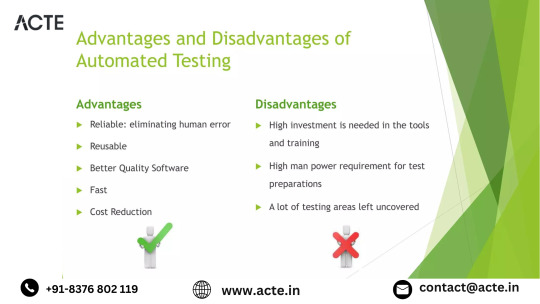
Conclusion:
Selenium stands as a robust ally in the testing arena, offering a spectrum of advantages for web application testing. However, understanding its limitations, especially in handling non-web applications and dynamic elements, is crucial. Testers must weigh these pros and cons, considering the learning curve and potential challenges, to make informed decisions about integrating Selenium into their testing toolkit.
In essence, Selenium empowers testing teams with flexibility and efficiency, serving as a reliable companion in ensuring the quality and reliability of software applications. As the testing landscape continues to evolve, Selenium remains a cornerstone, contributing to the ever-advancing field of software testing.
2 notes
·
View notes
Text
What Does It Take to Be a Successful Data Scientist in India?
So, you want to dive into the exciting world of Data Science in India? Well, grab your thinking cap and get ready for a rollercoaster ride through the data jungle! Here's the lowdown on what it takes to succeed:
1. Get Your Math Game On: First things first, you need to be buddies with math and stats. It's like the secret handshake of the data club.
2. Learning is a Lifestyle: Data Science is like that ever-changing friend who always has something new up their sleeve. So, be prepared to be a lifelong learner. Online courses are your BFFs.
3. Code Like a Pro: Learn Python and R – they're like the cool tools in your data toolbox. You'll use them to cook up amazing data dishes.
4. Sherlock Holmes Mode: Develop a superpower for problem-solving. You'll be the Sherlock Holmes of data mysteries.
5. Dive into a Domain: Choose a domain – like finance, healthcare, or e-commerce – that tickles your fancy. It's like picking your favorite ice cream flavor in the world of data.
6. Picasso of Data: Learn to paint pretty pictures with data. Tools like Tableau or Power BI will help you create data masterpieces that everyone can understand.
7. Pet Projects: Get your hands dirty with personal data projects. It's like gardening but with data. Showcase your green thumb in a portfolio.
8. Make Data Friends: Network with data nerds. Attend meetups, conferences, or just chat with fellow enthusiasts. You might find your data soulmate.
9. Mu Sigma Magic: Mu Sigma is like Willy Wonka's Chocolate Factory of Decision Science. They offer golden tickets to data lovers. Check out job openings at Mu Sigma and see if it's your golden ticket.
10. Soft Skills: Your charm matters too! You need to explain data stuff to folks who don't speak binary. Communication and teamwork are your secret weapons.
11. Be a Chameleon: The data world changes faster than a chameleon's colors. Be ready to adapt and embrace new challenges and tech like a pro.
In India, the data science scene is sizzling hot! There are plenty of juicy job opportunities, whether you're fresh out of college or a seasoned pro. So, gear up because it's time to rock the data world and make some sense out of the chaos, one byte at a time!
2 notes
·
View notes
Text
A TURN FROM B.Com OR BBA GRADUATE TO
DATA ANALYST

The business world is changing, and so are the opportunities within it. If you've finished your studies in Bachelor of Commerce (B.Com) or Bachelor of Business Administration (BBA), you might be wondering how to switch into the field of data analysis. Data analysts play an important role these days, finding useful information in data to help with decisions. In this blog post, we'll look at the steps you can take to smoothly change from a B.Com or BBA background to the exciting world of data analysis.
What You Already Know:
Even though it might feel like a big change, your studies in B.Com or BBA have given you useful skills. Your understanding of how businesses work, finances, and how organisations operate is a great base to start from.
Step 1: Building Strong Data Skills:
To make this change, you need to build a strong foundation in data skills. Begin by getting to know basic statistics, tools to show data visually, and programs to work with spreadsheets. These basic skills are like building blocks for learning about data.
I would like to suggest the best online platform where you can learn these skills. Lejhro bootcamp has courses that are easy to follow and won't cost too much.
Step 2: Learning Important Tools:
Data analysts use different tools to work with data. Learning how to use tools like Excel, SQL, and Python is really important. Excel is good for simple stuff, SQL helps you talk to databases, and Python is like a super tool that can do lots of things.
You can learn how to use these tools online too. Online bootcamp courses can help you get good at using them.
Step 3: Exploring Data Tricks:
Understanding how to work with data is the core of being a data analyst. Things like looking closely at data, testing ideas, figuring out relationships, and making models are all part of it. Don't worry, these sound fancy, but they're just different ways to use data.
Step 4: Making a Strong Collection:
A collection of things you've done, like projects, is called a portfolio. You can show this to others to prove what you can do. As you move from B.Com or BBA to data analysis, use your business knowledge to pick projects. For example, you could study how sales change, what customers do, or financial data.
Write down everything you do for these projects, like the problem, the steps you took, what tools you used, and what you found out. This collection will show others what you're capable of.
Step 5: Meeting People and Learning More:
Join online groups and communities where people talk about data analysis. This is a great way to meet other learners, professionals, and experts in the field. You can ask questions and talk about what you're learning.
LinkedIn is also a good place to meet people. Make a strong profile that shows your journey and what you can do. Follow data analysts and companies related to what you're interested in to stay up to date.
Step 6: Gaining Experience:
While you learn, it's also good to get some real experience. Look for internships, small jobs, or freelance work that lets you use your skills with real data. Even if the job isn't all about data, any experience with data is helpful.
Step 7: Updating Your Resume:
When you're ready to apply for data jobs, change your resume to show your journey. Talk about your B.Com or BBA studies, the skills you learned, the courses you took, your projects, and any experience you got. Explain how all of this makes you a great fit for a data job.
Using Lejhro Bootcamp:
When you're thinking about becoming a data analyst, think about using Lejhro Bootcamp. They have a special course just for people like you, who are switching from different fields. The Bootcamp teaches you practical things, has teachers who know what they're talking about, and helps you find a job later.
Moving from B.Com or BBA to a data analyst might seem big, but it's totally doable. With practice, learning, and real work, you can make the switch. Your knowledge about business mixed with data skills makes you a special candidate. So, get ready to learn, practice, and show the world what you can do in the world of data analysis!
***********
3 notes
·
View notes
Text
Becoming a Selenium Expert: Your Roadmap to Success
Selenium, the open-source web automation testing framework, has revolutionized the software testing industry by empowering testers to automate repetitive tasks and ensure the reliability of web applications. If you're looking to embark on a journey to master Selenium, you're in the right place. This comprehensive guide will take you through every step, from understanding the basics to mastering advanced topics, and even finding the best training resources to hone your skills.

Before you dive into the world of Selenium, it's crucial to establish a strong foundation in software testing and understand why test automation is essential.
Here's a step-by-step roadmap to kickstart your Selenium learning journey:
Understanding the Basics of Testing
Acquiring a solid understanding of software testing concepts is the foundation upon which your Selenium journey begins. It's crucial to grasp various testing types and recognize the significance of test automation in enhancing software quality. Software testing serves as the first line of defense against defects and errors, ensuring that the final product meets the desired quality standards. By understanding the basics of testing, you gain valuable insights into why Selenium automation is indispensable in today's software development landscape.
Learning the Fundamentals of Selenium
At the heart of Selenium automation lies Selenium WebDriver. To embark on your Selenium journey, you should start by comprehending its fundamentals. Selenium WebDriver acts as the bridge between your code and the web browser, enabling you to automate interactions with web elements. Fortunately, there is a wealth of online tutorials, documentation, and courses available to assist you in mastering Selenium. This powerful tool is your gateway to automating web testing, and a solid grasp of its fundamentals is essential for your success.
Choosing a Programming Language
Selenium is versatile in that it supports multiple programming languages, including Java, Python, C#, and more. When choosing a programming language, consider your comfort level and your eagerness to learn. Java, with its extensive community support and compatibility with Selenium, is a popular choice among practitioners. Your choice of programming language will be the medium through which you communicate with Selenium WebDriver, making it a pivotal decision in your Selenium journey.
Setting Up an Integrated Development Environment (IDE)
Efficiency is key when it comes to writing and executing Selenium scripts. To streamline your workflow, it's essential to install a suitable Integrated Development Environment (IDE) such as Eclipse or IntelliJ IDEA. These IDEs provide a conducive environment for coding, debugging, and running your Selenium scripts efficiently. Your IDE will become your trusted companion throughout your Selenium automation endeavors.
Mastering HTML and CSS
Selenium interacts directly with web elements, which underscores the importance of having a solid understanding of HTML and CSS. These foundational technologies govern the structure and style of web pages, and proficiency in them is crucial for locating and manipulating elements on web pages effectively. By mastering HTML and CSS, you equip yourself with the skills needed to navigate the web and interact seamlessly with the elements you encounter.
Practicing Locators
Web elements come in various shapes and sizes, and Selenium provides a range of locators to help you identify and interact with them effectively. Locators like XPath and CSS selectors are indispensable tools in your Selenium toolkit. Understanding how to use these locators to pinpoint web elements is a fundamental skill that will serve you well in your Selenium journey.
Hands-on Practice
Theory alone will only take you so far in mastering Selenium. To become proficient, you must put theory into practice. Initiate your Selenium journey by working on simple test scenarios and gradually progress to more complex ones. Real-world practice not only solidifies your understanding but also hones your problem-solving skills, a critical aspect of successful Selenium automation.
Exploring TestNG or JUnit
TestNG and JUnit are robust testing frameworks that seamlessly integrate with Selenium. They provide valuable features for organizing and managing your test cases effectively. Exploring these frameworks is a natural progression in your Selenium journey, as they enhance your ability to structure and execute tests systematically. TestNG and JUnit are powerful allies that will help you maintain control and organization in your automated testing endeavors.
Exploring Advanced Topics
Once you have established a solid grasp of the fundamentals, it's time to delve into more advanced aspects of Selenium. These advanced topics will not only deepen your understanding but also equip you with the skills needed to tackle complex web testing scenarios effectively.
Learning Automation Best Practices
In addition to mastering advanced topics, understanding and implementing automation best practices are crucial for becoming a proficient automation tester. These practices contribute to the efficiency, maintainability, and effectiveness of your automation projects.
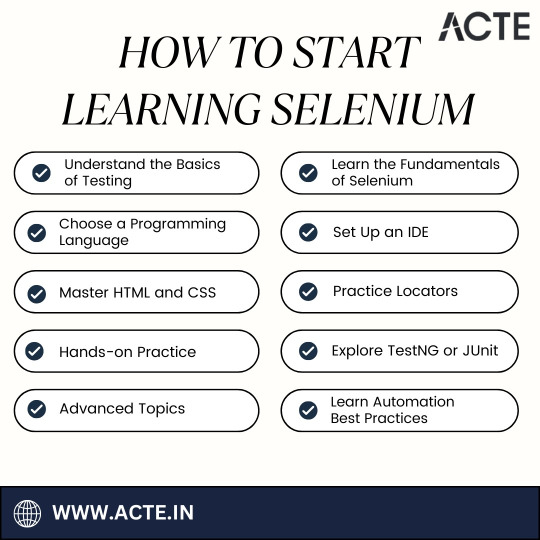
Embarking on your Selenium learning journey is an exciting and rewarding endeavor that opens doors to a world of possibilities in the realm of software testing and quality assurance. As you navigate the path from understanding testing basics to mastering Selenium's advanced features, remember that practice, perseverance, and a passion for continuous learning are your allies.
In your pursuit of excellence, consider seeking quality Selenium training and guidance. ACTE Technologies stands as a beacon in this regard, offering comprehensive Selenium training programs. These programs provide structured curricula, hands-on experience, expert instructors, and certifications that can validate your Selenium expertise.
So, embrace your Selenium learning journey with enthusiasm, apply your newfound skills in real-world scenarios, and consider the invaluable resources and training opportunities ACTE Technologies offers to further enhance your Selenium proficiency. With dedication and the right resources, you're well on your way to becoming a web automation testing expert. Happy learning!
3 notes
·
View notes